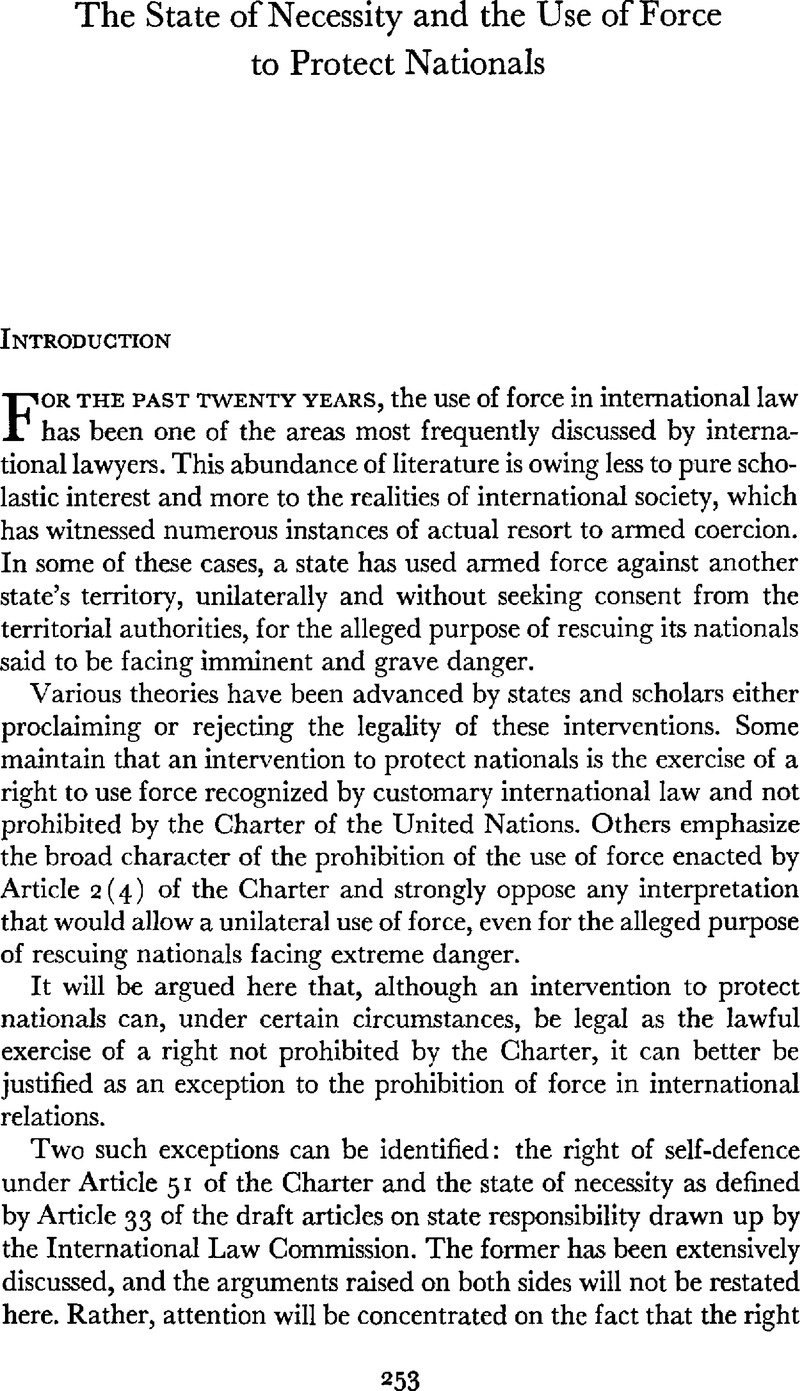Published online by Cambridge University Press: 09 March 2016

1 Case Concerning Military and Paramilitary Activities in and Against Nicaragua, [1986] I.C.J. Rep. 3, 94, para. 176.
2 Ibid., 103, para. 195.
3 Ibid., 122, para. 227.
4 Ibid., 119, para. 229.
5 Nguyen, Q.D., “La légitime défense d’après la Charte des Nations-Unies,” (1948) 52 R.G.D.I.P. 223, 242.Google Scholar
6 Case Concerning United States Diplomatic and Consular Staff in Tehran, [1980] I.C.J. Rep. 3, 29, para. 58.
7 supra note 1, at 64, para. 115.
8 Ibid., 104, para. 195; 119, para. 230; 122, para. 237.
9 Farer, T.J., “Drawing the Right Line,” (1987) 81 Am. J. Int’lL. 112, 113.CrossRefGoogle Scholar
10 Bowett, D., Self-defence in International Law 93 (Manchester, 1958).Google Scholar
11 Anzilotti, D., Cours de droit international, vol. 1, at 507 (Paris, 1939).Google Scholar
12 Report of the Commission to the General Assembly on the work of its 32nd session, Yearbook of the International Law Commission, 1980, vol. II, part a, A/35/10, at 34, para. 1.
13 Schwarzenberger, G., “Fundamental Principles of International Law,” (1955-I) 87 R.C.A.D.I. 91, 343.Google Scholar
14 Salmon, J., “Faut-il codifier l’état de nécessité en droit international?,” in Makarczyk, J. (ed.), Essays in International Law in Honor of Judge Manfred Lachs 235, 236 (The Hague, 1984).Google Scholar
15 Badr, G.M., “The Exculpatory Effect of Self-Defence in State Responsibility,” (1980) 10 Georgia J.I. Comp. L. 1,9.Google Scholar
16 de Visscher, C., Théories et réalités en droit international 339 (3rd ed., Paris, 1960).Google Scholar
17 Report of Professor Ago, Yearbook of the International Law Commission, 1980, vol. II, part 1, A/CN.4/318, ADD. 5–7, at 18, para. 10.
18 Schwarzenberger, supra note 13, at 343,” see also Report of Professor Ago, supra note 17, at 18, para. 9.
19 Sorensen, M., “Principes de droit international public,” (1960–III), 101 R.C.A.D.I. 1, 219–20.Google Scholar
20 For an extensive review, see supra note 12, at 47, para. 29, and supra note 17, at 46, para. 71.
21 supra note 12, at 35–45, para. 6–25; supra note 17, at 22–37, para. 21–55; Rousseau, C., Droit international public, vol. 5, at 92–95 (Paris, 1983)Google Scholar; Salmon, supra note 14, at 240–42, 248–50.
22 Ago, R., “Le délit international,” (1939-II) 68 R.C.A.D.I. 419, 544Google Scholar; see also supra note 17, at 39, para. 57; Guggenheim, P., Traité de droit international public, vol. 2, at 62 (Geneva, 1954)Google Scholar; supra note 11, at 510.
23 Summary records of the meetings of the 32nd session, Yearbook of the International Law Commission, 1980, vol. I, 1618th meeting, at 180, para. 21.
24 Rousseau, supra note 21, at 92–94.
25 Oscar Chin case, P.C.I.J. Series A/B, No. 63, at 113.
26 Zourek, J., “La notion de légitime défense en droit international,” (1975) 56 A.I.D.I. 1,66.Google Scholar
27 supra note 12, at 48, para. 30.
28 Sorensen, supra note ig, at aao.
29 J. Salmon, supra note 14, at 344.
30 Salmon, supra note 14, at 245.
31 supra note 12, at 48, para. 33.
32 supra note 17, at 20, para. 14; supra note 12, at 48, para. 33.
33 Salmon, supra note 14, at 347–48.
34 supra note 23, at 154, para. 43.
35 supra note 17, at 19, para. 12.
36 supra note 13, at 49, para. 32.
37 supra note 17, at 19, para. 12.
38 supra note 1 a, at 49, para. 32.
39 supra note 17, at 20, para. 15.
40 supra note 12, at 50, para. 35.
41 Ibid., 51, para. 40.
42 Schacter, O., “The Right of States to Use Armed Force,” (1984) 82 Mich. L.R. 1620, 1631.CrossRefGoogle Scholar
43 Ibid., 1637.
44 Weiler, J., “Armed Intervention in a Dichotomized World: The Case of Grenada,” in Cassese, A. (ed.), The Current Regulation of the Use of Force 247,250–51 (Dordrecht, 1986).Google Scholar
45 Bowett, D., “The Use of Force for the Protection of Nationals Abroad,” in Cassese, A. (ed.), Ibid., 39, 41.Google Scholar
46 Falk, R., “The United States and the Doctrine of Nonintervention in the Internal Affairs of Independent States,” (1959) 5 How. L.J. 163, 167.Google Scholar
47. Schweisfurth, T., “Operations to Rescue Nationals in Third States Involving the Use of Force in Relation to the Protection of Human Rights,” (1980) 23 G.Y.I.L. 159, 177–78.Google Scholar
48 (1980) 1155UNTS332.
49 Ronzitti, N., “Use of Force, Jus Cogens and State Consent,” in Cassese, supra note 44, at 147, 149.Google Scholar
50 Ronzitti, N., Rescuing Nationals Abroad through Military Coercion and Intervention on Grounds of Humanity 75 (Dordrecht, 1985).Google Scholar
51 supra note 49, at 153.
52 supra note 12, at 44, para. 23.
53 Ibid.
54 Ibid.
55 supra note 49, at 148.
56 See, inter alia, Rousseau, C., Droii international public, vol. 4, at 47 (Paris, 1980)Google Scholar; Lillich, R., “Forcible Self-Help by States to Protect Human Rights,” (1967) 53 Iowa L.R. 325, 349Google Scholar; Brownlie, I., International Law and the Use of Force by States 317 (Oxford, 1963)CrossRefGoogle Scholar; Ronzitti, op. cit. supra note 50, at 84.
57 Case Concerning United States Military and Paramilitary Activities in and Against Nicaragua, [1986] I.C.J. Rep. 3, 94, para. 176.
58 supra note 12, at 45, para. 25.
59 See the statement of the Belgian Prime Minister, Mr. Eyskens, to the Belgian Senate, on July 12, 1960, as quoted in Salmon, supra note 14, at 252; see the statements of the Belgian representative to the Security Council in U.N.S.C.O.R., 15th year, 1960, S/PV. 873, 873rd meeting, at 34, para. 18284, at 35, para. 192–93, and S/PV. 877, 877th meeting, at 30, para. 142.
60 As quoted in Sik, K. and Siekman, R., “Netherlands State Practice for the Parliamentary Year 1976,” (1978) 9 Neth. Y.I.L. 191, 234.CrossRefGoogle Scholar
61 Ronzitti, op. cit. supra note 50, at 51.
62 Stone, J., Of Law and Nations 36–37 (Buffalo, N.Y., 1974).Google Scholar